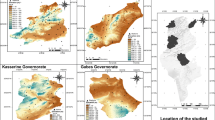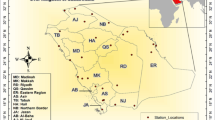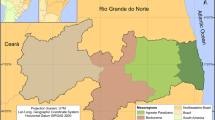Abstract
In arid and semi-arid countries, drought monitoring is a difficult issue to deal with, mainly due to the low density of precipitation measurement stations. The present study aims to evaluate the ability of the Tropical Rainfall Monitoring Mission (TRMM) 3B42 (v7) to monitor annual precipitation in Morocco. The accuracy of TRMM data to estimate annual rainfall was evaluated. Annual precipitations derived from 5113 daily TRMM 3B42 V7 data were compared to the corresponding in situ rainfall measurements from 23 rain gauges, between 1998 and 2012. The results showed a general, good linear relationship between TRMM and rain gauges data. When considering annual records, the Pearson correlation coefficient, R2, was equal to 0.73 and the Root Mean Square Error, RMSE, was equal to 159.8 mm/year. The correlation between rain gauge measurements and TRMM rainfall has been clearly improved when working with long-term annual average precipitation. The R2 increased to 0.79 and the RMSE decreased to 115.2 mm.
Access provided by Autonomous University of Puebla. Download conference paper PDF
Similar content being viewed by others
Keywords
1 Introduction
Rainfall is the main source of water for humans, animals and crops, and is the main factor affecting the socio-economic development of billions of peoples [7]. Indeed, drought occurs when precipitation is significantly below the normal value during a prolonged period [2, 10]. This phenomenon is the main factor affecting the socio-economic development of billions of peoples, especially in developing countries and in arid and semi-arid zones, where agriculture is the primary source of revenue [7].
Drought study is usually based on drought indicators analysis, also called drought indices. However, the main challenge of studying drought is the lack of precipitation measurements over large geographical areas. To overcome this problem, the use of remote sensing data appears more efficient in terms of accuracy, spatial coverage, and economical cost.
In this context, the present study aims to evaluate the accuracy of TRMM 3B42 V7 (Tropical Rainfall Measurement Mission) product to estimate annual rainfall in Morocco between 1998 and 2012. Rainfalls, derived from 5113 daily TRMM data, have been compared to the corresponding gauge rainfall’ measurements between 1998 and 2012, from 23 rain gauges.
2 Materials and Methods
The study area covers the whole Moroccan territory including its main agro-ecological zones. Mean annual air temperatures vary between 12 and 14 °C in winter, and 22 and 24 °C in summer, over the period 1950–2000. The annual rainfalls vary from less than 150 mm in the southern desert to more than 1000 mm in northern Morocco.
As part of this research, two data types were used: (1) daily rain datasets were collected by 23 rain gauges distributed over the half northern part of the study area between 1998 and 2012. These data were acquired from the National Meteorological Office of Morocco. Precipitation measurements were provided after undergoing quality control according to the recommendations of the World Meteorological Organization (WMO) and with less than 1% of missing data and (2) a time series of 5113 daily TRMM 3B42 Version 7 product [3], with a spatial resolution of 0.25° (approximately 25 km). These satellite-derived data were acquired from NASA’s official website of Tropical Rainfall Measuring Mission (https://pmm.nasa.gov/) for the period between January 1st, 1998, and August 31st, 2012. Firstly, annual precipitations were computed from the daily rain gauges’ data and from daily TRMM images. Secondly, annual precipitations derived from TRMM data were compared to annual precipitations measured by the 23 rain gauges.
3 Results
The scatterplot presented in Fig. 1a, compares annual precipitations measured by the 23 rain gauges and those derived from TRMM between 1998 and 2012. The presented data give a first general idea about the variability of annual rainfall in Morocco. Annual rainfall varies generally between less than 100 and 1000 mm with some extreme values that can reach 1600 mm. Furthermore, the comparison shows a generally-good linear relationship between the TRMM and rain gauges’ data. When considering all rain gauges together, the Pearson correlation coefficient, R2, is equal to 0.73 and the Root Mean Square Error, RMSE, is equal to 159.8 mm. When analyzing the rain gauges separately, the R2 varies between 0.43 and 0.92, with nearly 74% of the rain gauges having an R2 higher than 0.60, and the RMSE varies between 38 mm and 318 mm, and with more than 82% of the rain gauges having an RMSE lower than 200 mm.
Figure 1b illustrates the relationship between annual average precipitations measured by the 23 rain gauges and those retrieved from TRMM data between 1998 and 2012. The overall distribution of the annual averages of precipitation derived from TRMM is in a good agreement with the normal annual value measured by the majority of rain gauges. This figure also shows a high correlation between in situ measurements and TRMM average annual precipitations with R2 equal to 0.79 and RMSE equal to 115.2 mm.
4 Discussion
The results presented above are consistent with the previous studies conducted by Ouatiki et al. [6], Islam and Uyeda [4] and by Milewski et al. [5], and confirm the good performance of TRMM data at the annual timescale. The results also showed that in situ gauge precipitation is generally superior to TRMM data. Such a remark has already been observed in previous studies in the literature like [9] and by Ouatiki et al. [6]. In the literature, TRMM data produce the observed annual cycle with an overestimation or underestimation of rainfall amount during rainy seasons and dry seasons, respectively [1, 8]. In the Moroccan context of hydro-climatic heterogeneities, the agreement between TRMM and ground data is more significant in the plain area (arid/semi-arid) than in the mountainous zones with an overall acceptable accuracy [5, 6].
The comparison presented in this study showed that the correlation between gauge precipitations and TRMM rainfall has clearly been improved when working with long-term annual average precipitation. Indeed, the coefficient of correlation R2 increased from 0.73 to 0.79, and the RMSE decreased from 159.8 mm to 115.2 mm. Such results are very important in the context of this study since we are interested in analyzing drought trends in Morocco using TRMM data. These results are explained by the fact that the outliers’ effects are attenuated with increasing aggregation levels.
5 Conclusions
In this study, the robustness and the accuracy of the TRMM product to estimate annual rainfall in Morocco were evaluated. Annual precipitations derived from 5113 daily TRMM data were compared with the corresponding gauge rainfall measurements, between 1998 and 2012, from 23 rain gauges. The results showed a good relationship between the values computed from the two different sources of precipitation data. When considering annual data, the Pearson correlation coefficient, R2, was equal to 0.73 and the Root Mean Square Error, RMSE, was equal to 159.8 mm/year. The correlation between gauge measurements and TRMM rainfall has clearly been improved when working with long-term annual average precipitation. Indeed, the R2 increased from 0.73 to 0.79 and the RMSE decreased from 159.8 to 115.2 mm.
Despite the short period covered by this work, the obtained results showed the ability of remote sensing data (TRMM data in this case study) to estimate annual precipitation, and thus, to monitor meteorological drought over a large spatial scale. Such data could be a good tool to study drought, especially in zones where metrological stations are sparse, unevenly distributed, or not available at all. However, these findings need to be improved by testing new data sources and working on longer periods.
References
Almazroui, M.: Calibration of TRMM rainfall climatology over Saudi Arabia during 1998–2009. Atmos. Res. 99, 400–414 (2011). https://doi.org/10.1016/j.atmosres.2010.11.006
Ezzine, H., Bouziane, A., Ouazar, D.: Seasonal comparisons of meteorological and agricultural drought indices in Morocco using open short time-series data. Int. J. Appl. Earth Obs. Geoinf. 26, 36–48 (2014). https://doi.org/10.1016/j.jag.2013.05.005
Huffman, G.J., et al.: The TRMM multisatellite precipitation analysis (TMPA): quasi-global, multiyear, combined-sensor precipitation estimates at fine scales. J. Hydrometeorol. 8, 38–55 (2007). https://doi.org/10.1175/jhm560.1
Islam, M.N., Uyeda, H.: Use of TRMM in determining the climatic characteristics of rainfall over Bangladesh. Remote Sens. Environ. 108, 264–276 (2007). https://doi.org/10.1016/j.rse.2006.11.011
Milewski, A., Elkadiri, R., Durham, M.: Assessment and comparison of TMPA satellite precipitation products in varying climatic and topographic regimes in Morocco. Remote Sens. 7, 5697 (2015)
Ouatiki, H., et al.: Evaluation of TRMM 3B42 V7 rainfall product over the Oum Er Rbia watershed in Morocco. Climate 5, 1 (2017). https://doi.org/10.3390/cli5010001
Schilling, J., Freier, K.P., Hertig, E., Scheffran, J.: Climate change, vulnerability and adaptation in North Africa with focus on Morocco Agriculture. Ecosyst. Environ. 156, 12–26 (2012). https://doi.org/10.1016/j.agee.2012.04.021
Tao, H., Fischer, T., Zeng, Y., Fraedrich, K.: Evaluation of TRMM 3B43 precipitation data for drought monitoring in Jiangsu Province, China. Water (Switzerland) 8(6), 1–13 (2016). https://doi.org/10.3390/w8060221
Tramblay, Y., Thiemig, V., Dezetter, A., Hanich, L.: Evaluation of satellite-based rainfall products for hydrological modelling in Morocco. Hydrol. Sci. J. 61, 2509–2519 (2016). https://doi.org/10.1080/02626667.2016.1154149
Wilhite, D.A., Glantz, M.H.: Understanding: the drought phenomenon: the role of definitions. Water Int. 10, 111–120 (1985). https://doi.org/10.1080/02508068508686328
Author information
Authors and Affiliations
Corresponding author
Editor information
Editors and Affiliations
Rights and permissions
Copyright information
© 2021 The Editor(s) (if applicable) and The Author(s), under exclusive license to Springer Nature Switzerland AG
About this paper
Cite this paper
Hadria, R. et al. (2021). Evaluation of TRMM 3B42 V7 Rainfall Product in Morocco. In: Ksibi, M., et al. Recent Advances in Environmental Science from the Euro-Mediterranean and Surrounding Regions (2nd Edition). EMCEI 2019. Environmental Science and Engineering(). Springer, Cham. https://doi.org/10.1007/978-3-030-51210-1_298
Download citation
DOI: https://doi.org/10.1007/978-3-030-51210-1_298
Published:
Publisher Name: Springer, Cham
Print ISBN: 978-3-030-51209-5
Online ISBN: 978-3-030-51210-1
eBook Packages: Earth and Environmental ScienceEarth and Environmental Science (R0)





